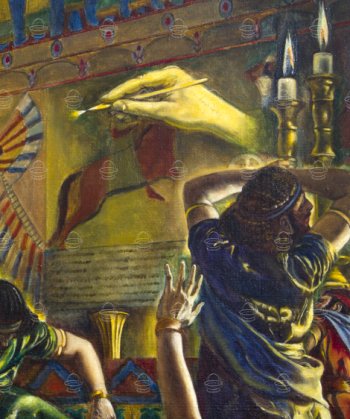
Click image to see large image
Belshazzar's Feast (1965)
The story of this picture comes from the Book of Daniel (chapter 5), that relates how King Belshazzar of Babylon, the son of Nebuchadnezzar, who had destroyed Jerusalem, held a drunken feast at which he used the gold and silver vessels plundered from the Temple of Solomon. The festivities were cut short by the appearance of the ‘Writing on the Wall’, the Hand of God predicting the downfall of his kingdom.
While all of NMK’s Biblical narrative pictures were highly original in their complex and dramatic compositions, Belshazzar’s Feast stands out on account of the richness of its palette. The artist rendered the interior of the king’s palace, its painted wall surfaces and tiled floor, as well as the silky textures of the men’s costumes, in deep jewel colours. He added some ‘props’ to make the scene look even more exotic, such as the king’s fan (and, in response to it, the display of feathers by the peacock in the foreground), the jade jar and the bowl of oranges.
Of course, Kadish knew Rembrandt’s famous painting of the same subject in London’s National Gallery. NMK’s picture differs from the old master’s in its much brighter palette and heightened sense of drama. On the rear wall, out of fear, one man is hugging the large wooden idol, with its blind carved eyes, an image which eloquently expresses the contempt for man-made gods that permeates this story and the whole of Jewish religious tradition.
Whereas Rembrandt chose to show the fingers of the ‘hand’ or ‘palm’ mentioned in the text writing directly on the wall, in Kadish's version an artist’s hand holding a paintbrush is poised to write the enigmatic message. He interpreted the ‘candlestick’ that served to illuminate the Hand of God as a pair of brass candlesticks. These were modelled on the candlesticks lit by Renée to bring in Shabbat [the Jewish Sabbath] every Friday night. These candlesticks were heirlooms brought over by her grandparents from Ukraine and are still in the family.